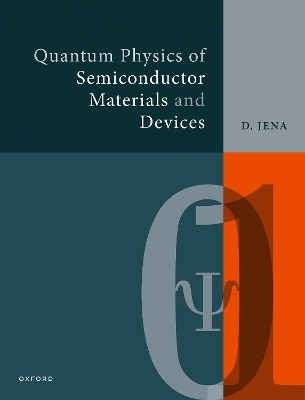
Quantum Physics of Semiconductor Materials and Devices
Oxford University Press (Verlag)
978-0-19-885685-6 (ISBN)
”Quantum Phenomena do not occur in a Hilbert space. They occur in a laboratory”. - Asher Peres
Semiconductor physics is a laboratory to learn and discover the concepts of quantum mechanics and thermodynamics, condensed matter physics, and materials science, and the payoffs are almost immediate in the form of useful semiconductor devices. Debdeep Jena has had the opportunity to work on both sides of the fence - on the fundamental materials science and quantum physics of semiconductors, and in their applications in semiconductor electronic and photonic devices. In Quantum Physics of Semiconductors and Nanostructures, Jena uses this experience to make each topic as tangible and accessible as possible to students at all levels.
Consider the simplest physical processes that occur in semiconductors: electron or hole transport in bands and over barriers, collision of electrons with the atoms in the crystal, or when electrons and holes annihilate each other to produce a photon. The correct explanation of these processes require a quantum mechanical treatment. Any shortcuts lead to misconceptions that can take years to dispel, and sometimes become roadblocks towards a deeper understanding and appreciation of the richness of the subject. A typical introductory course on semiconductor physics would then require prerequisites of quantum mechanics, statistical physics and thermodynamics, materials science, and electromagnetism. Rarely would a student have all this background when (s)he takes a course of this nature in most universities. Jena's work fills in these gaps and gives students the background and deeper understanding of the quantum physics of semiconductors and nanostructures.
Debdeep Jena is a Professor of Electrical and Computer Engineering and Materials Science and Engineering at Cornell University. His research and teaching interests are in the quantum physics, technology, and device applications of semiconductor and superconductor heterostructures such as III-V nitrides and oxides, and 2-dimensional crystals. He leads a research group that combines experiments and theory to investigate charge, heat, and spin transport in highly crystalline solids, and uses them to explore fundamental limits of electronic, photonic, and quantum devices. The research of this group has been published in approximately 300 papers, generated several patents, and recognized by international awards.
I Fundamentals
1: And Off We Go!
2: Secrets of the Classical Electron
3: Quantum Mechanics in a Nutshell
4: Damned Lies, and Statistics
5: Electrons in the Quantum World
6: Red or Blue pill: Befriending the Matrix
7: Perturbations to the Electron's Freedom
II Bands, Doping, and Heterostructures
8: Electrons in a Crystal get their Bands, Gaps and Masses
9: Bloch theorem, Bandstructure, and Quantum Currents
10: Crystal Clear: Bandstructure of the Empty Lattice
11: Tight-Binding Bandstructure
12: k . p Bandstructure
13: 1, 2, 3 ...: Pseudopotentials and Exact Bandstructure
14: Doping and Heterostructures: The Effective Mass Method
15: Carrier Statistics and Energy Band Diagrams
16: Controlling Electron Traffic in the k-Space
III Quantum Electronics with Semiconductors
17: Game of Modes: Quantized R, L, and C
18: Junction Magic: Schottky, pn and Bipolar Transistors
19: Zeroes and Ones: The Ballistic Transistor
20: Fermi's Golden Rule
21: No Turning Back: The Boltzmann Transport Equation
22: Taking the Heat: Phonons and Electron-Phonon Interactions
23: Scattering, Mobility, and Velocity Saturation
24: Through the Barrier: Tunneling & Avalanches
25: Running Circles: Quantum Magnetotransport
IV Quantum Photonics with Semiconductors
26: Let there be Light: Maxwell Equations
27: Light-Matter Interaction
28: Heavenly Light: Solar Cells and Photodetectors
29: Reach for the stars: Lasers and LEDs
30: Every End is a New Beginning
| Erscheinungsdatum | 17.08.2022 |
|---|---|
| Zusatzinfo | 645 line drawings and halftones |
| Verlagsort | Oxford |
| Sprache | englisch |
| Maße | 189 x 246 mm |
| Gewicht | 1888 g |
| Themenwelt | Naturwissenschaften ► Physik / Astronomie ► Festkörperphysik |
| Naturwissenschaften ► Physik / Astronomie ► Quantenphysik | |
| Technik ► Elektrotechnik / Energietechnik | |
| ISBN-10 | 0-19-885685-7 / 0198856857 |
| ISBN-13 | 978-0-19-885685-6 / 9780198856856 |
| Zustand | Neuware |
| Haben Sie eine Frage zum Produkt? |
aus dem Bereich


